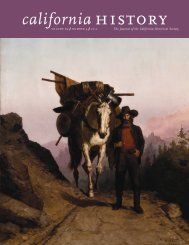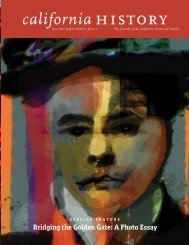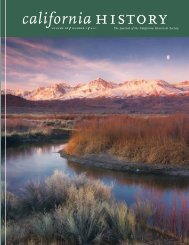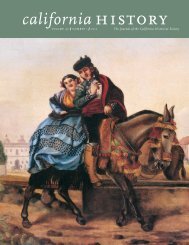are building a park on the land. We will take careof it and guard it, in the spirit of the CostanoanIndians. When the University comes with itsland title we will tell them: ‘Your land title is coveredwith blood. We won’t touch it. Your peopleripped off the land from the Indians a long timeago. If you want it back now, you will have tofight for it again.’” This politicization of People’sPark did not scare off the counterculture. Delacour,for example, believed that Bardacke hadmerely brought out the implications with “thewhole user thing which the Indians had” thatwere always inherent in the park issue. Nor didradicalization prevent the participation of moremoderate elements of the south campus community.John Coleman, a Berkeley graduatestudent, neighborhood resident, ordained priest,and self-described “part of the ‘Silent Majority,’”later depicted People’s Park as “a place of delightand whimsy”: “Street people in colorful hatsand costumes, students, middle-aged men withtheir teen-age sons, black and white, straight andhippie, they worked—sometimes two hundredstrong—in the hot afternoon sun, raking, digging,uprooting stubborn rocks, planting corn orflowers (some said they were marijuana), wateringsod. At the end of the afternoon they barbecued—sometimesa symbolic roast pig—drankwine and sang.” 28The formerly desolate vacant lot suddenly wastransformed by swings, slides, and sandboxes;flowers, grass, and three apple trees; abstractmetal sculptures, benches, and brick walkways.Alan Temko, architectural critic for the SanFrancisco Chronicle, praised the park’s foundersfor “starting a new era in democratic city planning”and pronounced People’s Park “the mostsignificant innovation in recreation design sincethe great public parks of the nineteenth and earlytwentieth centuries.” Van der Ryn compared theprocess of building the park to “the creation ofa frontier settlement” and the spirit of the parkbuilders to the heroic strain of “rugged individualism”prevalent in American <strong>history</strong> andfolklore. 29Twenty years later, Stew Albert reminisced nostalgically:“When people ask me, ‘What would yourpersonal view of heaven be like?’ I say, People’sPark. It was incredible. People were growingvegetables . . . people laying sod, planting rosebushes. There was a real kind of Walt Whitmanon a Sunday afternoon thing: a kind of blendingof play and work.” People’s Park, by bridging thechasm that once separated Bay Area politicos andhippies, exemplified the “hip-radical fusion” thatAlbert had envisioned. 30However, some Berkeley political radicals werenot thrilled with the partnership Albert hadbrokered. His former Progressive Labor comradesdismissed People’s Park as a “bourgeoisreformist” issue. In place of the Maoists, though,the park had gained the support of local southcampus residents, nonradicalized students, andfaculty sympathizers, making People’s Park farmore of a grassroots democratic movement thanits opponents realized. 31Act II: The Chancellor RespondsRoger Heyns arrived at UC Berkeley from theUniversity of Michigan in the autumn of 1965.An Iowa native, he had moved as a young childwith his family to Holland, Michigan. His devoutreligious upbringing convinced him to attendthe church-affiliated Calvin College, where hegraduated with a degree in psychology. At theUniversity of Michigan in Ann Arbor, he earneda master’s degree in psychology shortly beforeenlisting in the Army Air Corps in 1942. DuringWorld War II, he worked in the division of psychologicalservices, reaching the rank of captain.He returned to Ann Arbor after the war, receiveda doctorate in 1949, and joined the faculty. Anacclaimed teacher, he ultimately moved intoadministrative roles, first as dean and later asvice president for academic affairs. 321 <strong>California</strong> History • volume 88 number 1 2010
Upon taking office as chancellor at Berkeley,Heyns quickly established himself as a moderatingpresence between radical student demonstratorson the left and the newly elected conservativegovernor, Ronald Reagan, on the right. But inthe crisis over People’s Park, he failed at thetask. He waited too long to secure funding forhis projected soccer field and, when challengedwith the park’s construction, hesitated to assertuniversity ownership—by, for example, erectinga fence around the property as soon as plans tobuild the park were announced, thereby avoidingconfrontation.On April 30, following the creation of the parkand his declaration that “plans to build a playingfield are moving ahead,” Heyns advised: “In fairnessto those who have worked on the land, thedisutility of any additional labor must be pointedout.” Observing that park developers had paid noheed to his statement, he demanded on May 8the formation of a “responsible group” withwhom he could negotiate to “assure that furtherunauthorized development would be stopped.”He met later that day with a crosssection of parksupporters: Schlesinger, student body presidentCharles Palmer, student senator JondavidBachrach, and Van der Ryn. Collectively, theyrepresented the interest groups concerned withpreserving the park: the south campus “streetpeople” and UC students and faculty. 33It was definitely a “responsible group,” thoughone unwilling to accept Heyns’s agenda of halting“further unauthorized development.” NeitherSchlesinger nor Palmer believed that Heyns seriouslyconsidered the possibility of compromise.A disillusioned Schlesinger protested, “You can’tjust speak of building a soccer field—you haveto also speak of destroying a park.” And Palmerconsidered Heyns a deceitful individual: “Heynsdoesn’t have any real commitment. And he’s notan open man; he didn’t really level with us ortrust us when we tried to work with or negotiatewith him.” 34Ronald Reagan targeted UC student unrest during his gubernatorial bidin 1966, condemning campus disturbances on the campaign trail. Inthis San Francisco Chronicle cartoon, a gun-toting Sheriff Reagan atthe gates of the Berkeley campus exclaims, “Just show me one of themBeatnik varmints.” Reagan’s readiness for a showdown foreshadows theviolence of local law enforcement during the 1969 People’s Park protests.Courtesy of the San Francisco Chronicle; cartoon by Robert BastianVan der Ryn also doubted Heyns’s interest innegotiations. Nevertheless, he proposed a compromise.At his request, the university’s Collegeof Environmental Design enthusiasticallyadopted a resolution urging acceptance of a usercontrolledpark under the college’s sponsorship.The resolution stressed that a community park inthe eastern portion of the lot would not precludethe university’s construction of a soccer field inthe western segment. The plan had the amusedsupport of Michael Delacour, who described it asthe “idea that we’d be specimens in some kind oflaboratory and they’d all come and observe us.” 35Chancellor Heyns rejected the compromise, citingconcerns over the university’s legal liabilitiesshould injuries occur in the park and also over apetition signed by forty-eight area residents frustratedwith excessive noise, sanitation conditions,19
- Page 3: california historyvolume 88 number
- Page 6 and 7: c o l l e c t i o n sAdmission tick
- Page 8 and 9: c o l l e c t i o n sBusiness cards
- Page 10 and 11: People’s Park:Birth and SurvivalB
- Page 12 and 13: even on existing dorms due to the h
- Page 14 and 15: The attraction, however, was fleeti
- Page 16 and 17: Bay Area—North Beach and Haight-A
- Page 18 and 19: A hundred students, activists, and
- Page 22 and 23: and illegal drug use in the park. T
- Page 24: without even allowing Siegel to con
- Page 27 and 28: As Bloody Thursday came to a close,
- Page 29 and 30: this state.” On June 20, Reagan t
- Page 31 and 32: Denovo, her autopsy revealed a down
- Page 33 and 34: ation and encouragement, and shed n
- Page 35 and 36: the guardians of her children. The
- Page 37 and 38: mitted to visit Caroline in her new
- Page 39 and 40: Sojourner Truth gave what famously
- Page 41 and 42: After emancipation, she helped to o
- Page 43 and 44: This 1885 view captures the sparsel
- Page 45 and 46: But Caroline thought it imprudent t
- Page 47 and 48: The “Mother of Clubs”In Boston,
- Page 49 and 50: Caroline attended the September 189
- Page 51 and 52: ments, Seymour and Sibley earned pe
- Page 53 and 54: In this photograph, San Francisco s
- Page 55 and 56: n o t e s12People’s Park: Birth a
- Page 57 and 58: 1969; McGill, The Year of the Monke
- Page 59 and 60: that “thousands of the brightest
- Page 61 and 62: For Both Cross andFlag: Catholic Ac
- Page 63 and 64: d o n o r sThe California Historica
- Page 65 and 66: In Kind DonationsSandy Alderson, Sa
- Page 67: Membership BenefitsJoin tHeCaliforn









